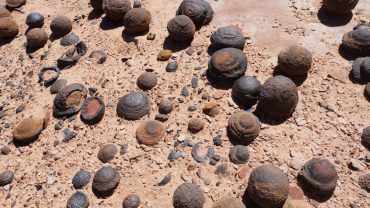Famed as much for its beauty as its troubled past, there’s surely only one name that comes to mind at the mention of a cursed diamond: Hope. This mesmerising 45-carat blue gemstone has left a trail of death and destruction in its wake, including royal beheadings, financial empires crumbling to dust, and personal tragedies.
But is there any truth to the Hope Diamond legend? We’re digging deep into the history, myths, and realities surrounding the Hope Diamond curse, so read on to find out more.
History of the Cursed Hope Diamond

Louis XVI and Marie Antionette (Credit: Sylvain Sonnet via Getty Images)
Sometime in the 17th century, a French merchant traveller by the name Jean Baptiste Tavernier, purchased a large blue diamond in India. Most likely originating from the Kollur mine in Golconda, it weighed roughly 115 carats by modern metrics.
In 1668, Tavernier sold the diamond to King Louis XIV, who had it recut, nearly halving its size. As part of the Royal Treasury, it became known as the “French Blue,” and would be passed down the generations to Louis XV and then to Louis XVI and Marie Antoinette. However, it disappeared in 1792, stolen amid the chaos of the French Revolution.
The French Blue was never specifically found. However, it’s now accepted that it turned up in London by 1812 in the hands of diamond merchant, Daniel Eliason. It would pass through many an illustrious hand over the decades, including its namesake, British banker Henry Philip Hope, and several prominent jewellers and socialites.
Origins of the Hope Diamond Legend

Evalyn Walsh McLean (r) wearing the Hope Diamond (Credit: Bettmann via Getty Images)
It’s unclear as to when or how the Hope Diamond legend originated. However, it was certainly filling newspaper columns in 1910, when it was bought by renowned jeweller Pierre Cartier. Some even say that Cartier used the myth as a sales pitch, to imbue the gem with mystique to appeal to its next owner, American heiress Evalyn Walsh McLean.
According to McLean’s autobiography, Cartier claimed that Tavernier had caused the curse of the Hope Diamond by stealing the gem from a Hindu idol. And that he had been its first victim, being mauled to death by a pack of dogs.
Other events attributed to the Hope Diamond curse include Louis XVI and Marie Antoinette’s gruesome executions, financier Thomas Hope’s financial ruin, and the tragic deaths of numerous subsequent owners.
As for Evalyn Walsh McLean, she suffered several personal tragedies, including the loss of her son and daughter and divorce from her husband, who subsequently and very publicly suffered from mental health issues.
These stories, rich in detail and steeped in misfortune, have captivated imaginations and solidified the belief in the Hope Diamond legend.
List of Hope Diamond Curse ‘Victims’

A stunning blue diamond (Credit: Mats Silvan via Getty Images)
The list of supposed victims of the Hope Diamond Curse is quite extensive, with some entries more famous than others. Here’s a run down of the most widely referenced recipients of the diamond’s supposed wrath:
Jean Baptiste Tavernier: According to legend, the curse began with Tavernier, who allegedly stole the diamond from a Hindu idol. He was reportedly torn apart by wild dogs on a trip to Russia, although there’s no historical evidence to support this claim.
Nicholas Fouquet: The superintendent of finances for King Louis XIV, who was imprisoned and eventually died in 1680 after reportedly wearing the diamond.
Louis XVI and Marie Antoinette: Both were guillotined during the French Revolution. Their association with the diamond is often cited as part of the curse.
Marie-Louise, Princess de Lamballe: A confidante of Marie Antoinette, she was murdered by a mob during the Revolution, and is also associated with the diamond.
Wilhelm Fals: A Dutch jeweller who recut the diamond. He was allegedly murdered by his son, who then committed suicide.
Simon Maoncharides: A Greek merchant who owned the diamond and sold it to Pierre Cartier in 1910. He reportedly drove his car off a cliff, contributing to the legend of the curse.
Evalyn Walsh McLean: After purchasing the diamond, she experienced multiple tragedies including the death of her son in a car accident and the breakdown of her marriage.
James Todd: The mailman who delivered the diamond to the Smithsonian Institution reportedly suffered a series of unfortunate events, including a truck accident, a head injury, and his house burning down.
Eerie Glow of the Cursed Hope Diamond

Blue diamond rings (Credit: Fruit_Cocktail via Getty Images)
As well as tales of misfortune, supporters of the Hope Diamond curse have often pointed to a peculiarity of the gem itself, namely that it emits a red glow under ultraviolet light. While all blue diamonds are phosphorescent under such light due to the presence of boron, most emit blue or white glows. Thus the red is certainly unusual. However, in 2008, scientists found that this was due to the diamond containing nitrogen in addition to boron.
Separating Myth from Reality

King Louis XIV of France (Credit: Richard Sharrocks via Getty Images)
While the tales of the Hope Diamond curse are compelling, a closer examination of historical records reveals a different picture. Many of the incidents attributed to the curse are lacking in any reliable sources to back them up, while others seem to be simply rumour and legend.
No evidence has been put forward regarding the claims about Tavernier stealing rather than buying the jewel, while the manner of his death is unknown. Other tales have plausible alternative explanations. The financial difficulties faced by Thomas Hope are a good example. It’s argued that these were likely due to broader economic factors rather than a cursed diamond.
Then there are the facts omitted from the legend. So that, while much was made of the grisly demise of King Louis XVI, it’s also worth noting that Louis XIV, who actually purchased the diamond, was and remains the longest reigning monarch of all time.
Other Cursed Diamonds

Some of the world's most famous diamonds (Credit: DiamondGalaxy via Getty Images)
The Hope Diamond curse is just one of many gems and treasures surrounded by folklore and superstitions found worldwide. For instance it’s often said that the Sancy, a 55.2-carat yellow diamond, was retrieved from the corpse of a servant who swallowed it. Then there’s the Koh-i-Noor, which has been blamed for cutting short the rule of many a maharaja.
Current Status of the Hope Diamond

19th century photograph of the Smithsonian in Washington, DC (Credit: ilbusca via Getty Images)
In 1958, the diamond’s then owner, jeweller Harry Winston, donated the gem to the Smithsonian Institution. Today, the Hope Diamond resides in the National Museum of Natural History in Washington DC, where it appears to be causing little trouble. So far at least…












